➗ Lecture 2
1/24
There's no tags or description
Looks like no tags are added yet.
Name | Mastery | Learn | Test | Matching | Spaced |
|---|
No study sessions yet.
25 Terms
Overall Theme
Survivors of 4 B years of evolution are organisms that constantly diversify genetically but are also programmed to be vulnerable to constant fitness selection
So diversify but select
Zygote Mitosis
Diploid zygote undergoes rounds of mitosis to form diploid gamete progenitor cells
Mutations can occur during these mitotic divisions
In higher animals, germline cells (cells that form gametes, sex cells) are set aside early in embryogenesis to reduce DNA damage from mitosis
Eggs are formed early and stored for decades → vulnerable to environmental mutagens
Sperm is formed continuously throughout life via mitosis
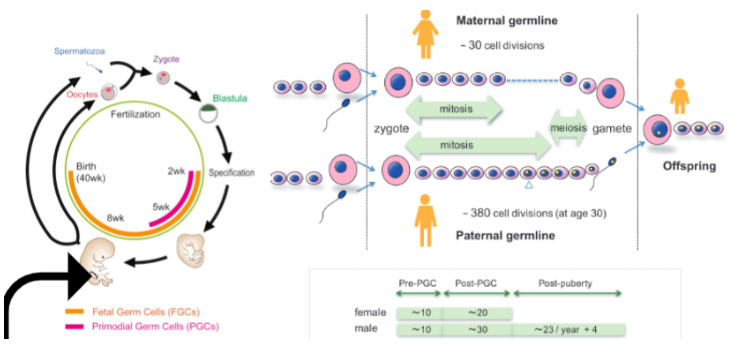
Plant Zygote Mitosis
Diploid zygote undergoes mitosis to form diploid gamete progenitor cells, mutations can occur
In plants, embryonic cells are at shoot apical meristem (SAM) → produces leaves, stem, branches
Quiescent center (QC) in SAM = low-rate mitotic stem cells
QC later converts SAM into floral meristem
Floral meristem forms carpel (female gonad which produces egg nuclei) and stamen (male gonad which produces sperm nuclei)
Plant germline is not set aside early → Many mitotic divisions occur before gametes form
Allows more chances for mutations → Some can be beneficial for adaptation
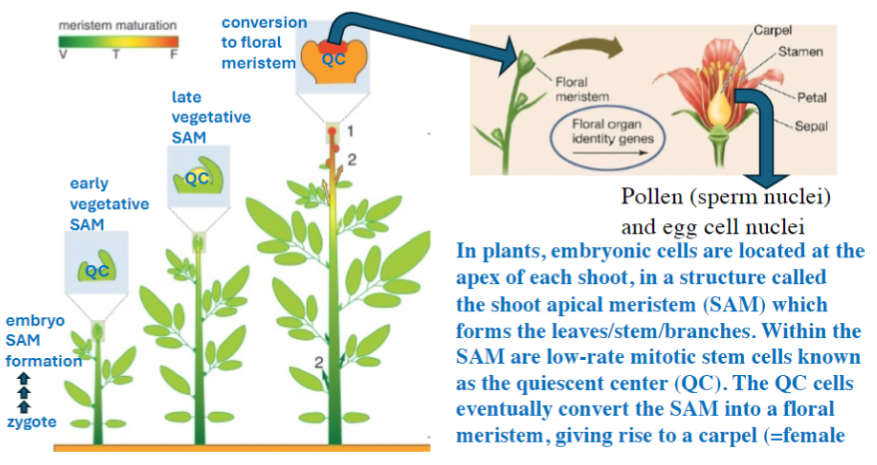
Gamete Formation
In animals: Eggs are formed during embryonic development (gestation), then stored until needed; sperm formed continuously after puberty
In plants: Gametes are not set aside early; instead, they are formed later from the floral meristem after many mitotic divisions
Gametes in Animals vs. Plants
Higher plants need more rounds of DNA-damaging mitosis to make gametes
Higher animals need fewer rounds of mitosis
Reflects difference in gamete formation process, not life strategy
Mechanistic difference, not strategy/survival difference
More mutations in plants potentially allows them to evolve at faster rate and adapt more
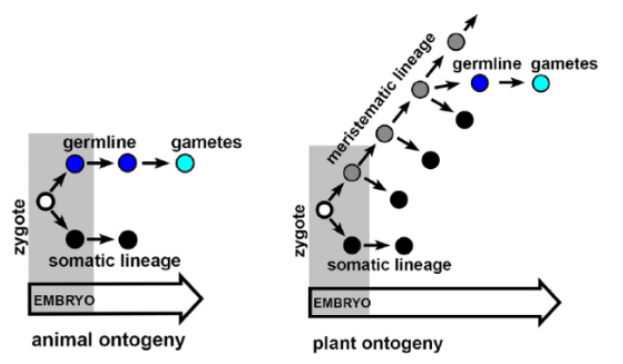
Meiosis
Meiosis creates haploid gametes (sperm/eggs)
Recombination (crossing over) occurs within homologous chromosomes from parents → Diversifies gametes
Chromosomes go on top of each other to “match up” areas
Independent assortment of whole homologous chromosomes from parents → Further diversifies gametes
Both processes increase genetic variation in offspring
Functions of Stages of Meiosis
Task 1: Reduce homologous chromosome number from diploid → haploid
Task 2: Chromosome recombination (crossing over) → Major driver of genetic diversity
Task 3: Random assortment of chromosomes → arguably most important driver of genetic diversity in eukaryotes
Meiosis Process
Original State: Diploid progenitor cell with 2 copies (homologs) of each chromosome
Chromosome Replication: Produces sister chromatids (46 chromosomes, 92 chromatids)
Pairing & Recombination: Maternal and paternal chromosomes pair and cross over (increases diversity)
Meiosis I:
Random assortment of homologs → Massive diversity
Each daughter cell gets one homologous chromosome from each pair → Ensures gametes have 50% of chromosomes (23 chromosomes, but 46 chromatids)
Meiosis II:
Sister chromatids separate → Each gamete gets half of each chromosome (23 chromosomes, 23 chromatids)
Final result: independent assortment + recombination → each sperm/egg is genetically unique genetic differences among siblings (except identical twins)
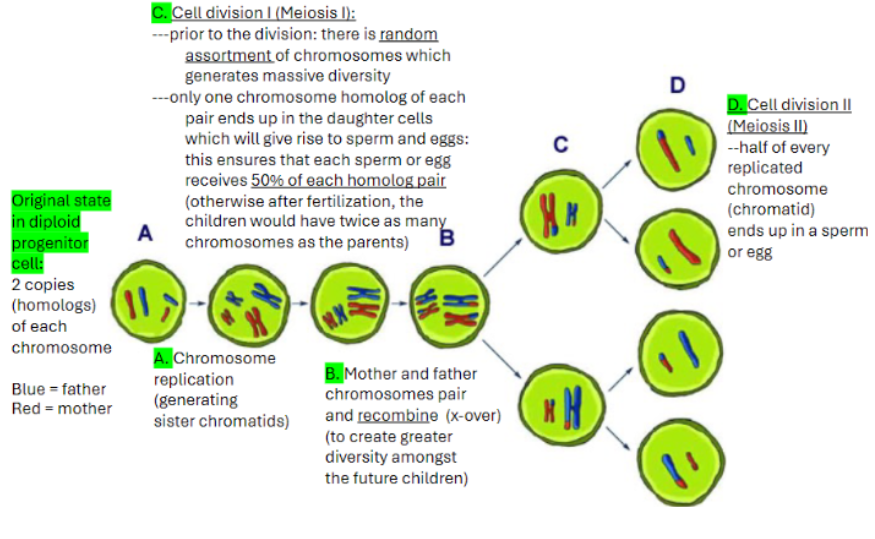
Outcome of Recombination
Maternal and paternal alleles from adjacent loci mix and form new combinations
Increases genetic diversity in gametes
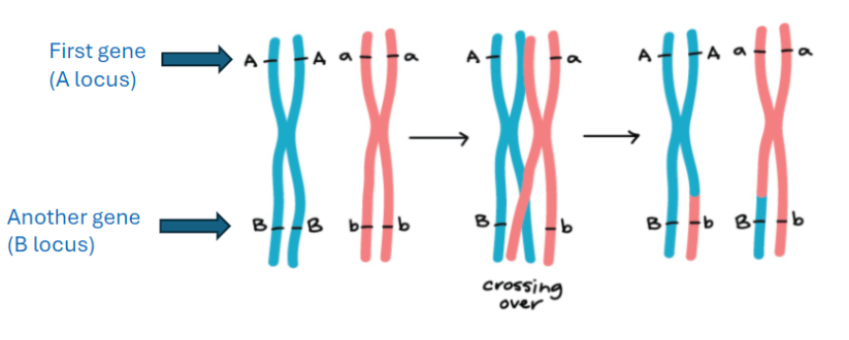
Crossing Over
Crossovers are relatively rare
Involve two double-strand DNA breaks → Accurate fusion needed
Mistakes can cause loss of entire chromosome arm
On average: 1 crossover per chromosome per meiosis
DNA Double-Strand Breaks (DSBs) in Meiosis
Occur in maternal and paternal chromosomes
Repair required to restore DNA integrity
Enables crossing over and recombination
Tightly regulated in terms of their timing, location, and frequency to ensure accurate chromosome separation and prevent genome instability
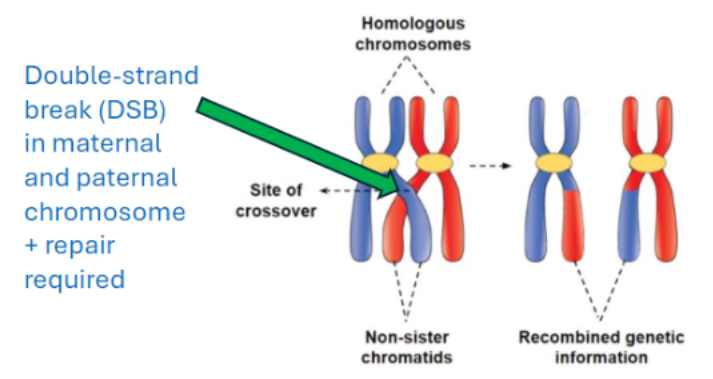
Crossing-Over and Genetic Diversity
Can occur nearly anywhere along a chromosome
Happens in all autosomal chromosomes → Enormous diversification potential
e.g. Each human chromosome has ~1000 genes so there are >1000 loci combinations can mix maternal/paternal alleles
Total possible combinations across autosomes: ~1000^22 → Millions of trillions of possibilities
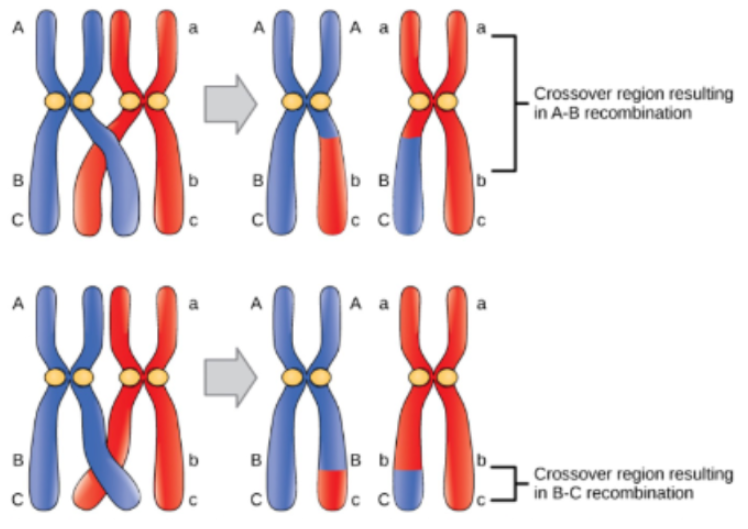
Sex Chromosome Recombination
Large regions of X and Y chromosomes do not recombine
X-X chromosomes can recombine normally
In X-Y, non-recombination is likely because X and Y evolved from a homologous autosomal pair → Now partially non-homologous
It’s hypothesized that originally, X and Y were fully homologous autosomes
Over evolution, Y lost many genes → No longer matches X along most of its length
Only small regions remain homologous → Allow limited recombination
Rest of X-Y pair is non-homologous → Cannot undergo crossing over safely
Y chromosome’s job is to repress X (female) for male trait manifestation?
Why We Have Multiple Chromosome Sets
Having all genes on one chromosome would reduce genetic diversity
Genes on the same chromosome are genetically linked
Linked genes have higher chance of being co-inherited after meiosis
Multiple chromosomes allow independent assortment → Increases genetic variation
Sexual organisms divide genes onto multiple chromosomes → Permits independent assortment to increases genetic diversity in sperm/eggs
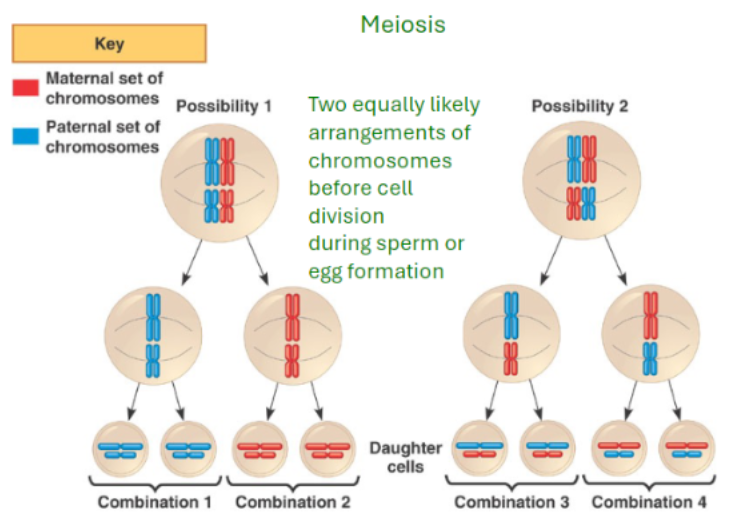
Generating Genetic Diversity in Meiosis
Independent, random assortment: Entire chromosomes shuffled → Thousands of alleles mixed
Chromosome recombination: Exchanges large chromosome chunks → Hundreds of genes mixed
Meiosis “tinkers” with many genes → Affects enzymes they encode
Meiosis I:
Random assortment of chromosomes → Generates diversity
Maternal and paternal chromosomes pair and recombine → Increases diversity b/w offspring
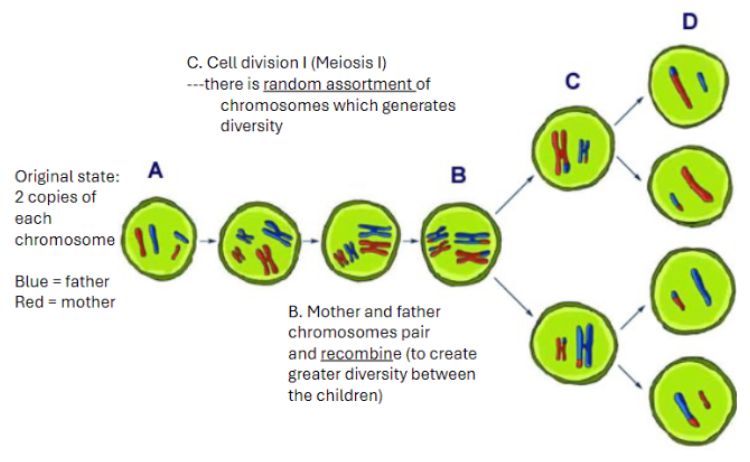
Independent Assortment
Arguably the greatest driver of genetic diversification in higher eukaryotes
23 sets of human chromosomes → 2²³ ≈ 8,388,608 (~8 million) possible combinations
A single man producing many sperm can generate massive genetic diversity
Every person is genetically unique → Within population, there is huge diversification potential within each generation
Meiosis and Genetic Processes Across Generations
Generation 1: DNA comes from parent’s chromosomes
Generation 2: Processes occur in you as fetus (females) and continue today (males)
Females: All oocytes begin meiosis during fetal development → Paused until puberty
Males: Spermatogonia are formed during fetal development but meiosis doesn’t start until puberty
Generation 3: Processes form gametes for your children
Genetic Ancestry and Gamete Fusion
Every sexual act combines two unique gametes from maternal and paternal lineages
Human chromosomes are a fusion of many ancestors
15 generations ago: DNA comes from 2¹⁵ = 32,768 ancestors (assuming no relatives)
~400 generations ago: Humans practiced crop agriculture → Ancestors were from different continents/environments
Humans began practicing crop agriculture
The ancestors lived in different regions and environments
Modern human DNA reflects mixing of these diverse ancestral populations
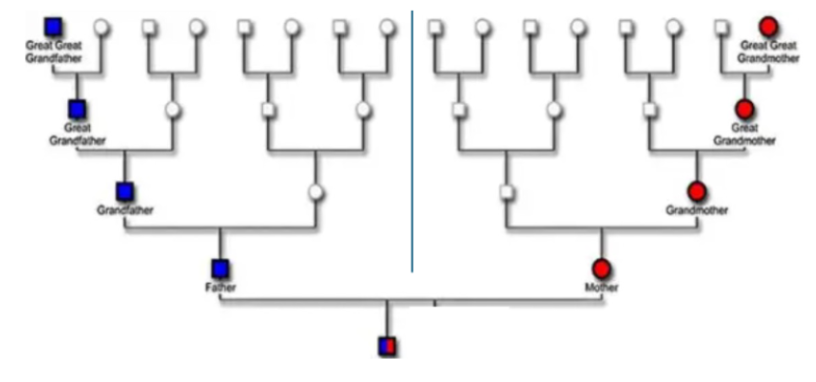
Genetic Diversification Across Generations
Diversification is additive and exponential
Additive: Occurs independently each generation
Exponential: Multiplies as progeny increase over generations
Each generation:
Inherits past diversity
Undergoes new recombination + independent assortment
Organisms with shorter lifespans can diversify faster
Raises question: Does lifespan variation among species relate to rate of genetic diversification?
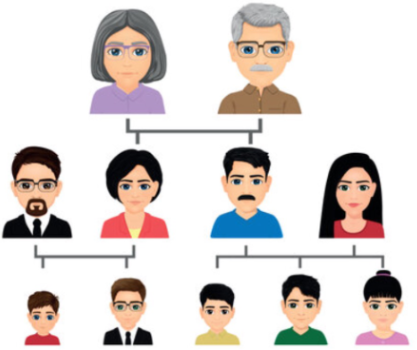
High Fecundity/Fertility and Lineage Diversification
Organisms with more offspring can diversify their lineage faster
Rapid population growth within a family increases genetic variation
Each individual has a unique allele combination → Higher chance some survive new diseases
Natural selection likely favored this process for survival
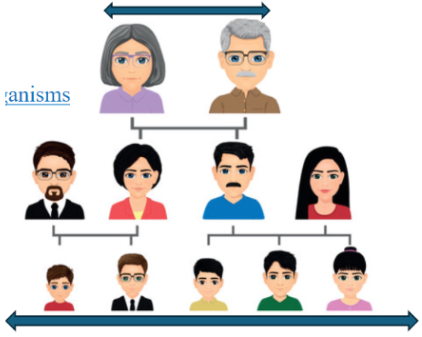
Multiplication Potential in Poultry Industry
Poultry have high fecundity → Produce many offspring quickly
Enables rapid genetic diversification within flocks
Supports fast population growth for production purposes
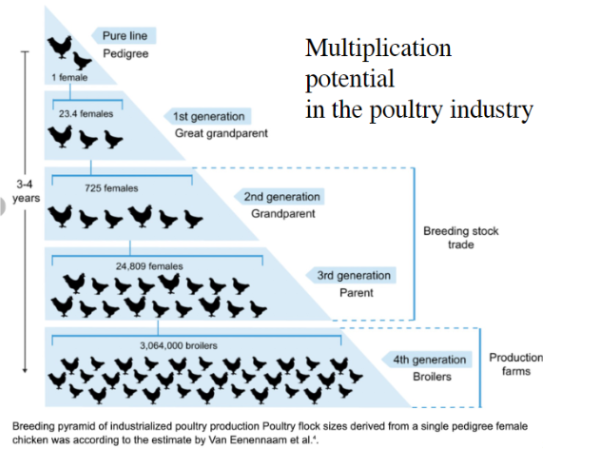
To Review
Somatic mutations: From zygote to gamete progenitor cells
Meiosis – Recombination: Crossing over within homologous chromosomes → Diversifies gametes
Meiosis – Independent assortment: Entire homologous chromosomes shuffled → Diversifies gametes
Sexual reproduction: Combines genomes from different ancestral lineages
Inter-generational diversification: Progeny multiplication increases diversity over generations
Final Outcome: Sources of Individual Uniqueness
Siblings differ from each other, parents, grandparents, etc.
Eukaryotic evolution favors those who diversify progeny
Additional sources of diversity:
Microbiome inheritance: From mother and other close contacts → “Social microbiology”
Cultural transmission: Knowledge from caregivers affects gene expression and fitness
Secondary influences: Parents, grandparents, etc.
Evidence: Genetically identical crops, livestock, pets can show phenotypic differences in different environments
Summary
Mitosis: Diploid zygote undergoes rounds of mitosis to form diploid gamete progenitor cells → Mutations can occur during this time
Meiosis – Independent assortment: Entire homologous chromosomes from grandparents are shuffled → Diversifies gametes
Meiosis – Recombination: Rare crossing over within homologous chromosomes from parents → Further diversifies gametes
Sexual reproduction: Combines two unique gametes from different ancestral lineages
Inter-generational diversification: Additive each generation, exponential as progeny multiply
Reading 1: Clarifying Mendelian vs non-Mendelian inheritance
Mendel’s Laws:
Segregation: 2 alleles of a gene separate into gametes during meiosis
Independent assortment: Alleles of unlinked genes segregate independently
Dominance affects phenotype, not inheritance
Common Misconceptions:
Traits like incomplete dominance, codominance, multiple alleles, sex-linked traits, and multigene traits are often mislabeled as non-Mendelian
Phenotypic ratios differ from Mendel’s classic 3:1 but genotypic ratios still follow Mendel’s laws
Examples of Mendelian Inheritance with altered phenotypes:
Incomplete dominance: Snapdragon flowers (red, pink, white) – 1:2:1 genotypic and phenotypic ratio
Codominance: Human AB blood type – 1:2:1 genotypic and phenotypic ratio
Multiple alleles: Mouse agouti gene – 2 alleles per individual segregate Mendelianly; dominance series affects coat color
Sex-linked traits: Hemophilia in humans – X-linked alleles segregate per Mendelian rules
Two-gene traits & epistasis: Purple pea flowers (P and C genes), Labrador coat color (E and B genes) – unusual phenotypic ratios arise but genotypic ratios remain Mendelian
Non-Mendelian Inheritance:
Organelle genes: Mitochondrial and chloroplast genes, usually maternally inherited
Epigenetics: DNA methylation, histone modification, paramutation, imprinting
Maternal-effect genetics: Phenotype depends on mother’s genotype, not offspring’s
Meiotic drive: Certain alleles transmitted preferentially, violating segregation
Main Message:
Inheritance should be classified based on genotypic ratios (reflecting allele segregation) rather than phenotypic ratios
Phenotypic variation does not imply non-Mendelian inheritance
Importance:
Accurate understanding of Mendelian principles is crucial for genetics education, healthcare, breeding programs, and interpretation of complex traits
Misleading online resources like Wikipedia or Khan Academy need expert review and clarification